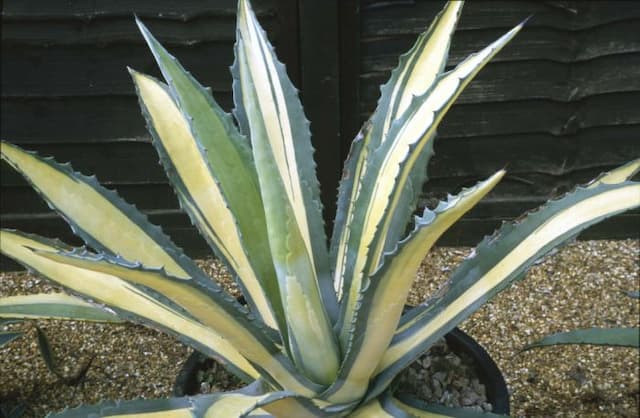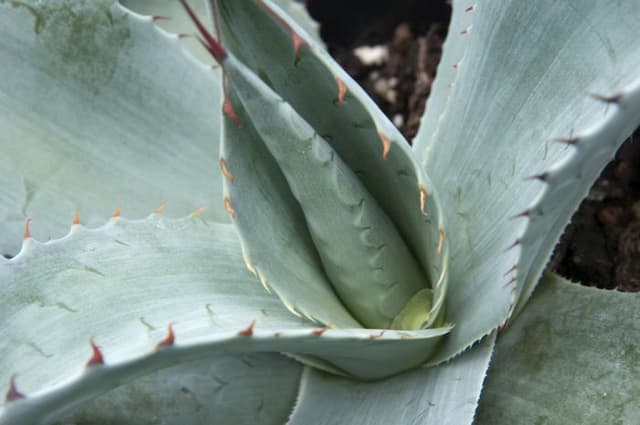Butcher's Broom Ruscus aculeatus 'John Redmond' (PBR) (f/m)

ABOUT
The plant known as 'John Redmond' is a cultivar of butcher's broom. It has a tough and evergreen appearance, characterized by its rich green foliage that resembles true leaves. These modified stems, known as cladodes, are sharply pointed at the tips and bear a striking resemblance to holly. Despite their leaf-like appearance, the true leaves are actually scales and are of no particular decorative value. The plant blossoms in the spring, bearing small white flowers in the center of the cladodes. This species is particularly interesting because it can produce flowers of both genders, sometimes even on the same plant. Following the blooming period, it may develop bright red berries which remain on the plant throughout winter, giving it additional ornamental appeal. The overall growth is dense and upright, providing a lush and compact appearance. Its dark foliage and contrasting red berries make it a visually striking addition to any garden setting, where it often serves as a low-maintenance ground cover or a textured backdrop for flowering plants.
About this plant
 Names
NamesFamily
Asparagaceae.
Synonyms
Butcher's Broom, Knee Holly, Jew's Myrtle, Sweet Broom, Pettigree.
Common names
Ruscus aculeatus.
 Toxicity
ToxicityTo humans
The common name for Ruscus aculeatus 'John Redmond' is Butcher's Broom. Butcher's Broom is generally considered not highly toxic to humans, but it can cause gastrointestinal upset if ingested. Possible symptoms after eating parts of the plant include nausea, vomiting, and abdominal pain. Care should be taken to avoid consuming this plant.
To pets
Butcher's Broom is also the common name when referring to the toxicity for pets. The plant is not typically highly toxic to pets, but it can still cause mild digestive upset if ingested. Symptoms of poisoning in pets may include vomiting, diarrhea, and abdominal discomfort. It is advisable to prevent pets from ingesting any part of this plant to avoid these possible negative effects.
 Characteristics
CharacteristicsLife cycle
Perennials
Foliage type
Evergreen
Color of leaves
Green
Height
2-3 feet (0.6-0.9 meters)
Spread
2-3 feet (0.6-0.9 meters)
Plant type
Shrub
Hardiness zones
7
Native area
Mediterranean
Benefits
 General Benefits
General Benefits- Evergreen Foliage: Retains its rich green leaves throughout the year, providing color and texture in the garden in all seasons.
- Drought Tolerance: Once established, it can withstand periods of dryness, reducing the need for frequent watering.
- Low Maintenance: Requires minimal care, making it ideal for busy gardeners or those looking for easy-to-maintain landscaping.
- Shade Tolerant: Capable of growing well in shaded areas where other plants may struggle, offering more planting versatility.
- Dense Growth Habit: Forms a thick, ground-covering mat that can help suppress weeds and reduce garden maintenance.
- Attracts Wildlife: Produces berries that can attract birds and provide food for wildlife during winter months.
- Decorative Berries: Female plants develop red berries that add ornamental value to the plant during the fall and winter seasons.
- Deer Resistance: Generally resistant to grazing by deer, making it suitable for gardens in areas where deer are a problem.
 Medical Properties
Medical Properties- This plant is not used for medical purposes.
 Air-purifying Qualities
Air-purifying QualitiesThis plant is not specifically known for air purifying qualities.
 Other Uses
Other Uses- Ruscus aculeatus 'John Redmond', commonly known as Butcher's broom, can be used in floral arrangements for its long-lasting foliage and distinctive appearance.
- The branches of the Butcher's broom can be crafted into small wreaths or decorative items due to their rigidity and evergreen nature.
- This plant's dense growth habit makes it suitable for creating low, defensive hedges in gardens or yards, acting as a deterrent to small animals.
- The wood from Butcher's broom has historically been used to make small tools or handles, taking advantage of its tough, hard-wearing properties.
- The bright red berries can be used as natural dyes or pigments, although care must be taken as the berries are not edible.
- As a landscaping plant, Butcher's broom can be used to stabilize soil on slopes and prevent erosion with its extensive root system.
- In crafts, the stiff leaves of Butcher's broom can be incorporated into brooms or whisk brushes, giving the plant its common name.
- The plant can serve as shelter for beneficial garden insects, which in turn can help with the biological control of pests.
- Dried stems of Butcher's broom can be used in potpourri mixes for decoration and adding texture to the composition.
- The branches and leaves can act as a protective layer in the garden mulch, providing insulation for more delicate plants during colder months.
Interesting Facts
 Feng Shui
Feng ShuiThe Butcher's-broom is not used in Feng Shui practice.
 Zodiac Sign Compitability
Zodiac Sign CompitabilityThe Butcher's-broom is not used in astrology practice.
 Plant Symbolism
Plant Symbolism- Protection: Ruscus aculeatus, commonly known as Butcher's Broom, has stiff, spine-tipped leaves that historically symbolize protection and defense.
- Resilience: Its ability to thrive in tough soil conditions and shade makes Butcher's Broom a symbol of resilience and adaptability in adverse conditions.
- Chastity: In the Middle Ages, Butcher's Broom was associated with chastity, likely due to its hidden flowers that are not easily seen, representing modesty.
- Humility: The plant's inconspicuous nature also lends it to symbolize humility, not drawing attention to itself amidst more showy flowers.
- New Beginnings: Butcher's Broom is an evergreen, symbolizing renewal and the everlasting, often linked with fresh starts and new beginnings.
 Water
WaterThe Butcher's Broom should be watered deeply once the top inch of soil feels dry to the touch, which would typically be about once a week, but this can vary depending on environmental conditions such as temperature and humidity. Water the plant with about 1-2 gallons, ensuring that the water is reaching the roots and not just wetting the surface. During winter, reduce watering to every other week or less, as the plant requires less moisture during this dormant period. Always check the soil moisture before watering to avoid overwatering, which can lead to root rot.
 Light
LightButcher's Broom thrives in partial to full shade, making it an ideal plant for spots that receive dappled sunlight throughout the day or areas with indirect light. Avoid placing it in intense, direct sunlight, as this can scorch the leaves. A north-facing window or a shady corner of a garden would be a suitable location for Butcher's Broom to receive the right light conditions.
 Temperature
TemperatureButcher's Broom prefers cool to moderate temperatures, thriving best in environments where the temperature stays between 50°F and 70°F. It can tolerate temperatures as low as 10°F and can survive brief periods of frost. For optimal growth, keep the plant away from hot drafts and sudden temperature changes.
 Pruning
PruningPruning Butcher's Broom is primarily for shaping or removing dead foliage. Trim the plant in early spring before new growth starts, cutting back any unwanted or overcrowded shoots to maintain plant health and desired appearance. Pruning is not frequently necessary for Butcher's Broom, but doing it occasionally helps to encourage healthy growth and a tidy form.
 Cleaning
CleaningAs needed
 Soil
SoilButcher's-broom prefers well-drained soil with a slightly acid to neutral pH between 5.5 and 7.5. A mix of loam, sand, and peat moss is ideal to ensure proper drainage and aeration.
 Repotting
RepottingButcher's-broom should be repotted every 2-3 years to refresh the soil and accommodate root growth, doing so in late winter or early spring.
 Humidity & Misting
Humidity & MistingButcher's-broom thrives in moderate humidity levels around 40-60%, similar to typical indoor environments, without requiring special adjustments.
 Suitable locations
Suitable locationsIndoor
Place in bright, indirect light and keep soil lightly moist.
Outdoor
Plant in partial shade with well-draining soil; shelter from wind.
Hardiness zone
7-9 USDA
 Life cycle
Life cycleRuscus aculeatus 'John Redmond', commonly known as Butcher's Broom, initially begins its life cycle as a seed, which germinates in moist, shaded conditions, ideally in well-draining soil. Once the seedling emerges, it develops into a young plant with spiky, green foliage that resembles leaves but are actually flattened stems called cladodes. As it matures over several years, the plant reaches its adult phase, characterized by dense foliage and the development of small, inconspicuous flowers that sprout from the center of the cladodes; these flowers eventually give rise to red berries when fertilized. Each individual plant is either female or male, and so for berries to be produced, both genders must be present to facilitate cross-pollination. Butcher's Broom is a perennial, so once established, it enters a cycle of seasonal growth and dormancy, with growth typically occurring in spring and summer, followed by a period of relative inactivity in the colder months. The plant can spread through the rhizomes under the soil, slowly forming thick clumps over many years.
 Propogation
PropogationPropogation time
Spring to Early Summer
For the plant commonly known as Butcher's Broom and scientifically named Ruscus aculeatus 'John Redmond' (PBR) (f/m), the most popular method of propagation is by division of rhizomes or root clumps. This process usually takes place in the late winter or early spring just before new growth commences. To propagate by division, the clump of the plant should be carefully dug up and the rhizomes or root clumps should be separated, ensuring that each new section has at least one growing point or bud. These sections can then be replanted in well-prepared soil with good drainage at the same depth they were previously growing. It's important to water the new plants thoroughly after planting to help settle the soil around the roots.



![Beschorneria [Flamingo Glow]](/_next/image?url=https%3A%2F%2Fplants-admin.emdemapps.com%2Fimages%2Fplants%2F%2Fimages%2F604b59df2e78d.png&w=640&q=75)




